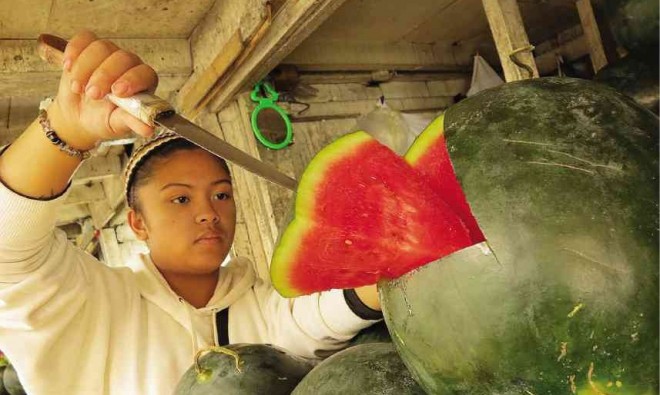
WATERMELONS harvested in farms in Bani town in Pangasinan province are sold in the Baguio City market for P50 to P150 apiece. EV ESPIRITU
Black Leopard, Super Jumbo, Kaneko and Takii. To a visitor of Bani town in the western part of Pangasinan province, these words sound like names of characters in a Japanese animé film.
But to farmers of Bani, these are the watermelon varieties that have earned them the reputation of producing the country’s sweetest and juiciest watermelons.
“We have been planting these in our farms because these are suited to our soil,” says Ardie Oineza, vice president of the newly organized Pakwan (Watermelon) Growers Association of Bani.
In his three-hectare farm in the upland village of San Simon, the watermelon varieties look the same: Round, dark green-skinned and with bright red flesh.
“It must be the quality of our soil,” says Oineza, who went into watermelon planting in 1995.
According to Bani’s official website, watermelon production was unheard of in the town before 1986.
For three years, agriculturists then hosting the radio program “Farmers School on the Air,” gave out instructions to farmers on watermelon planting. “It was a hit and miss affair,” the website says.
But in 1989, a farmer in Barangay (village) Banog Norte, who planted watermelon on a commercial scale, had a good yield. This had encouraged farmers in other villages to follow in his footsteps.
A decade later, other farmers earned at least P20 million from watermelon production.
“To top it all, Bani farmers have mastered the technology. This has earned for the town the reputation as the home of the sweetest, the juiciest and the reddest watermelons in the country,” the website says.
‘Not much’
Oineza says that compared with last year, he did not earn much this watermelon season, which began in October and will end this month.
He says his watermelon farm, where he spent P41,000 for his production input, earned for him last week P363,000. “Last year, I planted in only two hectares, but I made P300,000,” he says.
On the average, a watermelon grower earns a minimum of P35,000 for every P20,000 spent for farm inputs. “The lowest they could earn is P20,000, which is still 100 percent of their capital,” says Bani Mayor Gwen Palafox-Yamamoto.
Farmers also plant rice, corn and vegetables during the rest of the year.
Yamamoto says at least 160 ha of farms in her town are now planted with watermelons.
Pakwan festival
To help the farmers promote their product, the town is holding its first Pakwan Festival on Feb. 6 to 9.
“The town government provides seeds to help farmers. We also helped them form an association to protect them [from unscrupulous traders],” says Yamamoto.
There were instances in the past, she says, when buyers did not pay farmers. “This is why I advised them to form an association and come up with an accreditation for their buyers,” she says.
Oineza relates that he once had a buyer who got two truckloads of watermelons from his farm but who mixed all these with watermelons harvested from another province.
“Then, when they sold the watermelons they said they all came from Bani,” he says.
He says farmers are happy that the Bani government is moving to brand and market the watermelons produced in the town.
Off season
Oineza says that after all his watermelons are harvested this year, he will start planting anew in February. “These will be harvested in April. This is what our buyers want. The price is good because by that time, it will already be off-season,” he says.
He also planted 20 more varieties of watermelons in a demonstration farm to enable him to choose other varieties that will be best suited for his farm.
“I think all kinds of watermelons are there now, all colors, sizes and shapes,” Oineza says.
Last year, he grew Diana, a small oblong, yellow watermelon variety with red flesh and it earned him money. Diana, which weighs up to three kilograms when ripe, has a farm gate price of P40 a kg. “But when it reaches the fruit stands, it’s about P90 a kg,” Oineza says.
Among the watermelons in his demonstration farm are New Dragon, an oblong, striped watermelon with yellow flesh; Klondyke, also oblong-shaped with red flesh; Bright Gem, which is round, green but black striped; and Aubrey, which can grow only up to 2 kg.